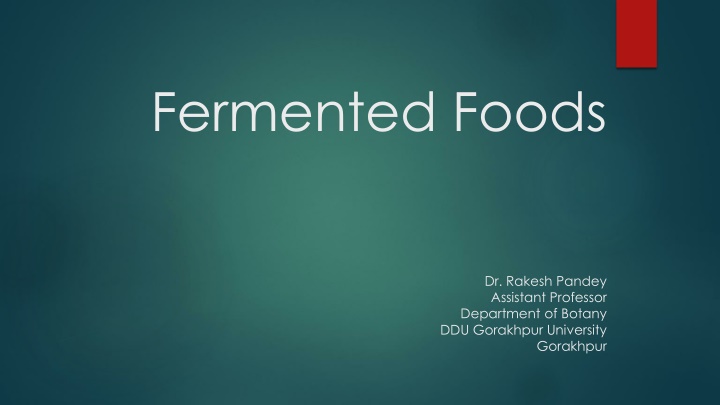
Discover the Power of Fermented Foods for Health and Flavor
Explore the world of fermented foods with Dr. Rakesh Pandey, an Assistant Professor at DDU Gorakhpur University. Learn about the benefits of fermented foods, the fermentation process, live vs. processed microbes, and examples of fermented foods. Discover how fermented foods can improve taste, texture, and digestibility, while also providing potential health benefits.
Download Presentation

Please find below an Image/Link to download the presentation.
The content on the website is provided AS IS for your information and personal use only. It may not be sold, licensed, or shared on other websites without obtaining consent from the author. If you encounter any issues during the download, it is possible that the publisher has removed the file from their server.
You are allowed to download the files provided on this website for personal or commercial use, subject to the condition that they are used lawfully. All files are the property of their respective owners.
The content on the website is provided AS IS for your information and personal use only. It may not be sold, licensed, or shared on other websites without obtaining consent from the author.
E N D
Presentation Transcript
Fermented Foods Dr. Rakesh Pandey Assistant Professor Department of Botany DDU Gorakhpur University Gorakhpur
Fermented Foods are those foods that are made through desired microbial growth and enzymatic conversions of food components. These foods are not new. Fermented foods have been around for thousands of years. One of the best known example of fermented foods is Yogurt. Yogurt is a milk-based fermented food. During yogurt fermentation bacteria grow on the sugar and other nutrients in milk. As the number of bacteria rises, the bacteria produce compounds that change nutrients in the milk to form yogurt. lactic acid-producing the flavor, texture, and
The Value of Fermented Foods- May be a source of live, active microbes. Improve taste, texture, and digestibility of food. Increase concentrations compounds in foods. Remove/reduce toxic substances or anti-nutrients in raw foods. Inhibit pathogens and food spoilage microbes. May benefit human health by reducing risk for some acute and chronic diseases. of vitamins and bioactive
The Fermentation Process- Depending on the food, certain types of bacteria, yeasts and/ or molds carry out the fermentation. Ingredients such as salt may be added and temperature and time will be manipulated to get the desired end- product. The fermentation microbes are still alive when we eat yogurt, kefir, cheeses, kimchi and some other fermented foods. But some foods that undergo fermentation are further processed (by pasteurization, baking, or filtering) so they are no longer sources of live microbes.
Fermented Foods Retaining Live Fermentation Microbes- Yogurt Kefir Most Cheeses Miso Natto Tempeh Kimchi/ fermented vegetables Dry fermented sausages Most Kombuchas Some Beers
Fermented Foods with Fermentation Microbes Killed or Removed (Process) Bread, including sourdough (Baked) Shelf-stable pickles/fermented vegetables (Heat-treated) Sausage (Heat-treated) Soy sauce (Heat-treated) Vinegar (Heat-treated) Wine, most beers, distilled spirits (Filtered) Coffee and Chocolate beans (Roasted)
Not Fermented Foods (No Live Microbes Used in Production)- Fresh Sausage Vegetables pickled in brine or vinegar Chemically-produced soy sauce Non-fermented cured meats and fish Acidified cottage cheese
